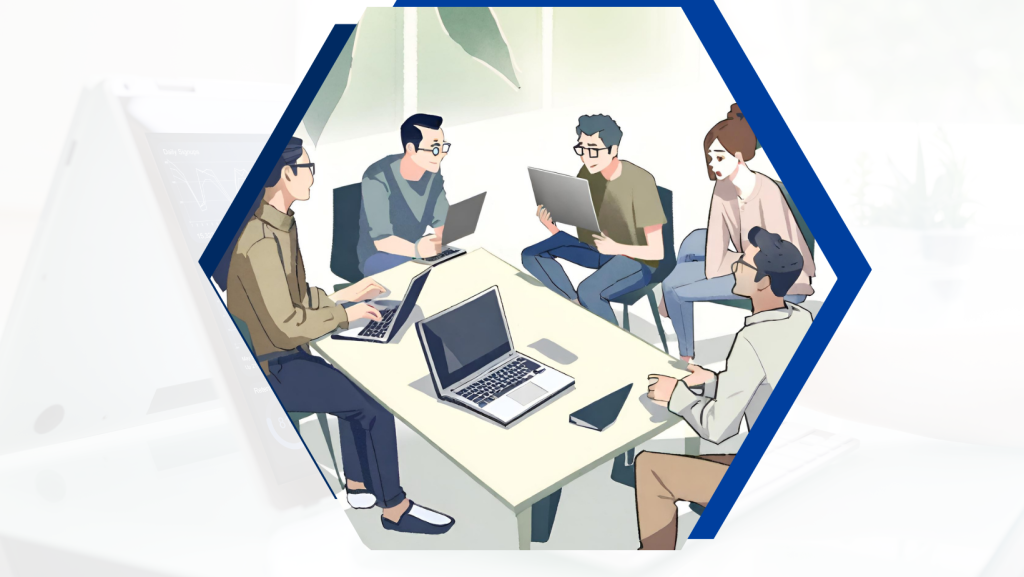In the world of custom software development, achieving success hinges on understanding, collaboration, and strategizing. To capture our client’s goals effectively, E-gineering deploys a combination of tools and techniques during the discovery process. In this article, we’ll delve into the pivotal activities and artifacts that compose the discovery phase, empowering our teams to generate accurate estimates and timelines while aligning our vision with your needs.
An Agile Mindset: Faster Time to Market
At the heart of E-gineering’s software development approach is our commitment to agile frameworks and practices. For over 20 years, we have proven we can deliver value by breaking down complex projects into manageable increments, allowing for swift adjustments in response to evolving requirements. Embracing an agile mindset empowers us to craft robust and efficient solutions that are capable of evolving alongside your business.

Stakeholder Interviews: Shaping the Vision
Stakeholder interviews form the bedrock of our discovery process. These discussions aim to ascertain your vision for the project, how it aligns with your broader business objectives, and how success – as well as potential pitfalls – will be defined. Engaging with your stakeholders sets a solid foundation for the project and ensures everyone actively participates in crafting its success. It’s a critical step in setting expectations and comprehending the project’s strategic goals.
User Research: Putting Users at the Center
User research serves as the crucial compass that steers development in the precise direction users intend to go. Prioritizing a deep comprehension of your end-users is absolutely vital to understanding your diverse personas and use cases. It empowers our team to craft solutions that are not just user-friendly and intuitive, but also finely tailored to cater to the specific needs of those who will engage with the final product. E-gineering’s emphasis on “walking a mile in their shoes” confirms that our designs resonate with your users’ goals and objectives.
Alignment Meetings: Ensuring Consensus
Sometimes, the initial vision and your users’ needs may not perfectly align. E-gineering believes that alignment meetings play an important role in bridging this gap and fostering consensus among stakeholders. These meetings are pivotal in identifying additional opportunities for enhancing the customer experience, confirming that everyone actively contributes to the project’s common goal.
Technical Analysis: Assessing Infrastructure
Before plunging into development, it’s essential to conduct a comprehensive analysis of the technical aspects of the project. An integral part of our discovery process is understanding your current infrastructure, individuals, teams, and expertise so that design decisions and solutions delivered can be supported by your team long after we are gone. Through this analysis, we can unearth deficiencies and constraints while uncovering opportunities for reuse, consolidation, and training. The time spent delving into your “today state” proves invaluable when making decisions about the project’s technical architecture.
Requirement Workshops: Collaborative Requirement Gathering
Requirement workshops are collaborative sessions designed to capture functional requirements. Techniques like storyboarding, user story creation, story mapping, and acceptance criteria definition help outline the project’s functionality in detail. Through this exercise, we assure the development team and stakeholders share a unified understanding of what the end product should accomplish.
Solution Design: Building the Foundation
At this point in the process, we’ve discussed your problems, pain points, and requirements, and we are ready to work with you to design a solution. Our technical expertise and your knowledge of your business domain are ready to be put together. Solutions could be as varied as deploying an off the shelf solution, writing a custom software application, or even leveraging powerful cloud services to take advantage of advanced features such as Data Analytics or AI. It all depends on what we’ve learned to this point. For one solution, maybe security and performance are most important, for another, maybe cost and usability.
Application Design: Visualizing the Solution
With a clear understanding of the target platform and technologies, we advance to high-level application design. This involves creating screen flow diagrams and wireframing critical workflows. These visual representations help stakeholders envision the end product and provide valuable insights into the user experience.
Creating Essential Artifacts
Throughout the discovery process, our team focuses on generating key artifacts that play a crucial role in creating a comprehensive project proposal. These artifacts are essential in propelling the project forward with speed and precision.
Functional Requirements:
Confirming that all basic feature requirements are documented, ideally using user stories and acceptance criteria.
Screen Flow Diagram:
Designing the application’s screen flow based on functional requirements, platform knowledge, and user experience principles.
Wireframes/Interaction Design:
Constructing wireframes for each platform and orientation, which can be converted into low-fidelity prototypes if usability testing is desired.
Screen Mockups/Visual Design:
Our graphic designers create design concepts and screen mockups, illustrating the product’s look and feel, including custom components, animations, and behavior.
Iteration Plan:
Using the design artifacts and functional requirements as a base, E-gineering will collaborate closely with you to define and refine an MVP (Minimal Viable Product) backlog. The backlog should be focused on the features that would attract early adopters and to validate early assumptions. This iterative approach not only allows for valuable feedback and adjustments along the way but also includes periodic product demonstrations to showcase the evolving progress. This dynamic feedback loop will allow us to be certain that we are consistently delivering value that aligns with your vision and objectives.
Conclusion
The success of a software development project relies on a well-executed discovery process. By employing a combination of tools and techniques such as stakeholder interviews, user research, alignment meetings, technical analysis, requirement workshops, architectural recommendations, and application design, E-g teams can produce a comprehensive project proposal. This not only aids in estimating project scope and timeline accurately, but also supports our primary intention – that the end product aligns with your vision and the needs of your users. Through our agile project discovery, software development becomes a truly client-centric endeavor, setting the stage for a successful project from kick-off to hand-off.
 The E-gineering Advocate Program
The E-gineering Advocate Program